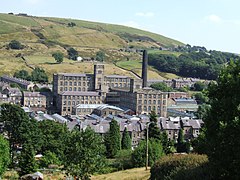Bank Bottom Mill
| Bank Bottom Mill | |
|---|---|

Bank Bottom Mill
|
|
| Alternative names | Marsden Mill |
| General information | |
| Type | Industrial Mill |
| Architectural style | late Georgian |
| Town or city | Marsden, West Yorkshire |
| Country | England |
| Coordinates | 53°35′48″N 1°55′46″W / 53.59667°N 1.92944°WCoordinates: 53°35′48″N 1°55′46″W / 53.59667°N 1.92944°W |
| Construction started | Early 19th century |
| Completed | 1824 |
| Technical details | |
| Structural system | Brick |
Bank Bottom Mill, later known as Marsden Mill, was an important centre for the production of woollen cloth in Marsden, West Yorkshire, England. Production of cloth ceased in 2003.
Bank Bottom Mill is a four storey structure which dates from 1824, and was originally a fulling mill. In the 1830s it was used by Norris, Sykes and Fisher. Later it was occupied by John Sykes and Sons.
In 1834 Norris, Sykes and Fisher participated in the report of the Factories Commissioners into the Employment of Children in Factories, and as to the Propriety and Means of Curtailing their Labour. According to the answers given by the firm to the Commissioners, the firm had commenced manufacture of woollen cloth in 1824, using water power driven by the river Wessenden. They employed a number of children in the mill, some below ten years of age. Boys and girls under ten were paid 3 shillings a week, about half what an adult might receive, and were "employed in piecing for slubbers and mules, and feeding scribbling and carding machines". A regular working week for all workers was sixty nine and a half hours, with days off on Sunday, Christmas Day and Good Friday, and "about six other half days during the year".
The firm was not enthusiastic about the prospect of legislation on the question of child labour:
In the late 19th century Bank Bottom Mill was taken over by Joseph, William and Elon Crowther. Their company, John Crowther and Sons, was named after their late father John Crowther, who was a woollen manufacturer from Golcar, West Yorkshire.
By this time the mill was one of the largest cloth-producing mills owned by a single individual in the world. The floor space of the mill was 57,592 square yards, and contained forty three sets of carding machines and six hundred and eighty looms in production in the early part of the twentieth century.
At the start of the twentieth century, the smaller mills at Bank Bottom closed, gradually replaced by five bigger companies. These were: John Edward Crowther, New Mill (owned by Crowther Bruce and Co), Clough Lea Mill (owned by J. B. Robinson), Cellar’s Clough Mill (owned by Fisher, Firth & Co), and Holme Mills (owned by S, & C. Firth). Business boomed during the 1914-18 war, thanks to the huge demand for woollen cloth needed to clothe men in uniform. King George V and Queen Mary visited the mill on 30 May 1918, as a mark of appreciation of the contribution it was making to the continued war effort.
...
Wikipedia
